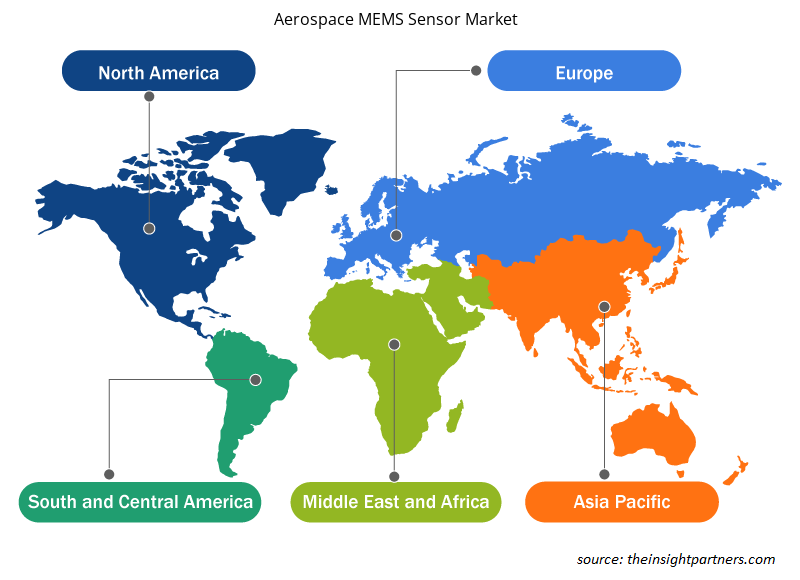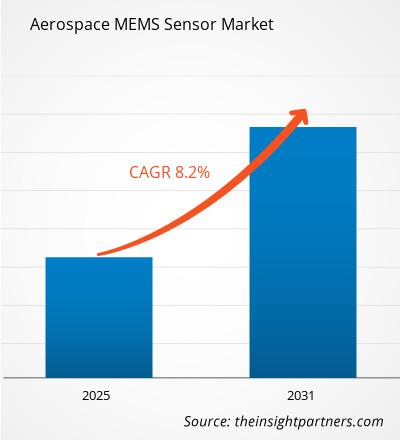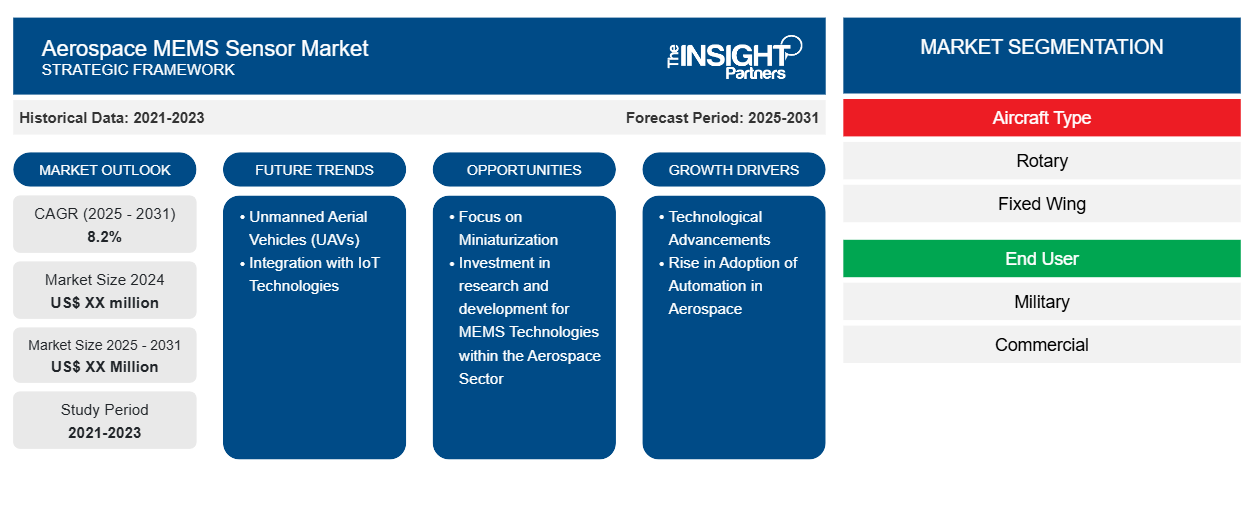Der Markt für MEMS-Sensoren für die Luft- und Raumfahrt wird voraussichtlich von 2023 bis 2031 eine durchschnittliche jährliche Wachstumsrate (CAGR) von 8,2 % verzeichnen, wobei die Marktgröße von XX Millionen US-Dollar im Jahr 2023 auf XX Millionen US-Dollar im Jahr 2031 wachsen wird.
Der Bericht ist nach Flugzeugtyp (Drehflügler, Starrflügelflugzeuge) segmentiert. Der Bericht präsentiert außerdem Analysen basierend auf dem Installations-Endbenutzer (Militär, Gewerbe). Die globale Analyse ist weiter auf regionaler Ebene und in den wichtigsten Ländern aufgeschlüsselt. Der Bericht bietet den Wert in USD für die oben genannte Analyse und Segmente.
Zweck des Berichts
Der Bericht Aerospace MEMS Sensor Market von The Insight Partners zielt darauf ab, die aktuelle Landschaft und das zukünftige Wachstum sowie die wichtigsten treibenden Faktoren, Herausforderungen und Chancen zu beschreiben. Dies wird verschiedenen Geschäftspartnern Einblicke geben, wie zum Beispiel:
- Technologieanbieter/-hersteller: Um die sich entwickelnde Marktdynamik zu verstehen und die potenziellen Wachstumschancen zu kennen, damit sie fundierte strategische Entscheidungen treffen können.
- Investoren: Durchführung einer umfassenden Trendanalyse hinsichtlich der Marktwachstumsrate, der finanziellen Marktprognosen und der Chancen entlang der Wertschöpfungskette.
- Regulierungsbehörden: Zur Regulierung von Richtlinien und Überwachungsaktivitäten auf dem Markt mit dem Ziel, Missbrauch zu minimieren, das Vertrauen der Anleger zu bewahren und die Integrität und Stabilität des Marktes aufrechtzuerhalten.
Marktsegmentierung für MEMS-Sensoren für die Luft- und Raumfahrt
Flugzeugtyp
- Drehbar
- Starrflügel
Endbenutzer
- Militär
- Kommerziell
Passen Sie diesen Bericht Ihren Anforderungen an
Sie erhalten kostenlose Anpassungen an jedem Bericht, einschließlich Teilen dieses Berichts oder einer Analyse auf Länderebene, eines Excel-Datenpakets sowie tolle Angebote und Rabatte für Start-ups und Universitäten.
- Holen Sie sich die wichtigsten Markttrends aus diesem Bericht.Dieses KOSTENLOSE Beispiel umfasst eine Datenanalyse von Markttrends bis hin zu Schätzungen und Prognosen.
Wachstumstreiber auf dem Markt für MEMS-Sensoren für die Luft- und Raumfahrt
- Technologische Fortschritte: Die Marktnachfrage nach MEMS-Sensoren für die Luft- und Raumfahrt wird stark von fortwährenden technologischen Innovationen beeinflusst. Fortschritte im MEMS-Bereich verbessern kontinuierlich die Sensorleistung, Miniaturisierung und Integrationsmöglichkeiten, die sich zunehmend für Anwendungen in der Luft- und Raumfahrt eignen.
- Zunehmende Einführung von Automatisierung in der Luft- und Raumfahrt: Der Luft- und Raumfahrtsektor erlebte eine rasant wachsende Nachfrage nach Automatisierung des Sektors sowie nach verbesserten Sicherheitsfunktionen. Höhere Sicherheitsstandards, verbesserte Navigation, Steuerungssysteme und allgemeine Flugzeugsicherheit durch MEMS-Sensoren treiben ihre Einführung in moderne Designs der Luft- und Raumfahrtindustrie voran.
Zukünftige Trends auf dem Markt für MEMS-Sensoren für die Luft- und Raumfahrt
- Unbemannte Luftfahrzeuge (UAVs): Chancen bei UAVs Mit der zunehmenden kommerziellen Nutzung von UAVs in den Bereichen Überwachung, Lieferung, Landwirtschaft und anderen Anwendungen werden dem MEMS-Sensormarkt enorme Chancen zugeschrieben. Die Hauptkomponente des UAV sind MEMS-Sensoren, die für Navigation und Stabilität verwendet werden und somit Wachstumschancen in diesem Bereich schaffen.
- Integration mit IoT-Technologien: MEMS-Sensoren lassen sich auch in Technologien des Internets der Dinge (IoT) integrieren, die Möglichkeiten zur Erfassung und Analyse von Daten in Luft- und Raumfahrtanwendungen bieten, um die Betriebseffizienz zu verbessern und so eine vorausschauende Wartung zu ermöglichen, was MEMS-Sensoren für die Luft- und Raumfahrtindustrie noch wertvoller macht.
Marktchancen für MEMS-Sensoren für die Luft- und Raumfahrt
- Fokus auf Miniaturisierung: Die jüngsten Trends bei MEMS-Sensoren konzentrieren sich stark auf die Miniaturisierung, was auch die Entwicklung noch kompakterer und leichterer Versionen ermöglicht. Insbesondere bei Anwendungen in der Luft- und Raumfahrt ist eine effiziente Gewichtsreduzierung im Rahmen der Kraftstoffeffizienz und Leistungsentwicklung erforderlich.
- Investitionen in Forschung und Entwicklung für MEMS-Technologien im Luft- und Raumfahrtsektor: Hohe Investitionen in Forschung und Entwicklung im Luft- und Raumfahrtsektor im Bereich MEMS-Technologien sind ebenfalls ein Wachstumsfaktor für diesen Markt in den kommenden Jahren. Die Verbesserung der Sensorfunktionen und die weitere Entdeckung neuer Anwendungen würden somit das Marktwachstum ankurbeln.
Regionale Einblicke in den Markt für MEMS-Sensoren für die Luft- und Raumfahrt
Die regionalen Trends und Faktoren, die den Markt für MEMS-Sensoren für die Luft- und Raumfahrt im Prognosezeitraum beeinflussen, wurden von den Analysten von Insight Partners ausführlich erläutert. In diesem Abschnitt werden auch die Marktsegmente und die Geografie von MEMS-Sensoren für die Luft- und Raumfahrt in Nordamerika, Europa, im asiatisch-pazifischen Raum, im Nahen Osten und Afrika sowie in Süd- und Mittelamerika erörtert.

- Erhalten Sie regionale Daten zum Markt für MEMS-Sensoren für die Luft- und Raumfahrt
Umfang des Marktberichts zu MEMS-Sensoren für die Luft- und Raumfahrt
| Berichtsattribut | Details |
|---|---|
| Marktgröße im Jahr 2023 | XX Millionen US-Dollar |
| Marktgröße bis 2031 | XX Millionen US-Dollar |
| Globale CAGR (2023 - 2031) | 8,2 % |
| Historische Daten | 2021-2022 |
| Prognosezeitraum | 2024–2031 |
| Abgedeckte Segmente | Nach Flugzeugtyp
|
| Abgedeckte Regionen und Länder | Nordamerika
|
| Marktführer und wichtige Unternehmensprofile |
|
Marktteilnehmerdichte für MEMS-Sensoren für die Luft- und Raumfahrt: Auswirkungen auf die Geschäftsdynamik verstehen
Der Markt für MEMS-Sensoren für die Luft- und Raumfahrt wächst rasant. Dies wird durch die steigende Nachfrage der Endnutzer aufgrund von Faktoren wie sich entwickelnden Verbraucherpräferenzen, technologischen Fortschritten und einem größeren Bewusstsein für die Vorteile des Produkts vorangetrieben. Mit der steigenden Nachfrage erweitern Unternehmen ihr Angebot, entwickeln Innovationen, um die Bedürfnisse der Verbraucher zu erfüllen, und nutzen neue Trends, was das Marktwachstum weiter ankurbelt.
Die Marktteilnehmerdichte bezieht sich auf die Verteilung der Firmen oder Unternehmen, die in einem bestimmten Markt oder einer bestimmten Branche tätig sind. Sie gibt an, wie viele Wettbewerber (Marktteilnehmer) in einem bestimmten Marktraum im Verhältnis zu seiner Größe oder seinem gesamten Marktwert präsent sind.
Die wichtigsten Unternehmen auf dem Markt für MEMS-Sensoren für die Luft- und Raumfahrt sind:
- Merit Medical Systems, Inc.
- MEMSCAP
- Collins Luft- und Raumfahrt
- Japan Luftfahrtelektronikindustrie, Ltd.
- Micralyne, Inc.
Haftungsausschluss : Die oben aufgeführten Unternehmen sind nicht in einer bestimmten Reihenfolge aufgeführt.

- Überblick über die wichtigsten Akteure auf dem Markt für MEMS-Sensoren für die Luft- und Raumfahrt
Wichtige Verkaufsargumente
- Umfassende Abdeckung: Der Bericht deckt die Analyse von Produkten, Diensten, Typen und Endbenutzern des Marktes für MEMS-Sensoren für die Luft- und Raumfahrt umfassend ab und bietet einen ganzheitlichen Überblick.
- Expertenanalyse: Der Bericht basiert auf dem umfassenden Verständnis von Branchenexperten und Analysten.
- Aktuelle Informationen: Der Bericht stellt durch die Abdeckung aktueller Informationen und Datentrends Geschäftsrelevanz sicher.
- Anpassungsoptionen: Dieser Bericht kann angepasst werden, um spezifische Kundenanforderungen zu erfüllen und die Geschäftsstrategien optimal anzupassen.
Der Forschungsbericht zum Markt für MEMS-Sensoren für die Luft- und Raumfahrt kann daher dabei helfen, die Branchensituation und Wachstumsaussichten zu entschlüsseln und zu verstehen. Obwohl es einige berechtigte Bedenken geben kann, überwiegen die allgemeinen Vorteile dieses Berichts tendenziell die Nachteile.
- Historische Analyse (2 Jahre), Basisjahr, Prognose (7 Jahre) mit CAGR
- PEST- und SWOT-Analyse
- Marktgröße Wert/Volumen – Global, Regional, Land
- Branchen- und Wettbewerbslandschaft
- Excel-Datensatz
Aktuelle Berichte
Verwandte Berichte
Erfahrungsberichte
Grund zum Kauf
- Fundierte Entscheidungsfindung
- Marktdynamik verstehen
- Wettbewerbsanalyse
- Kundeneinblicke
- Marktprognosen
- Risikominimierung
- Strategische Planung
- Investitionsbegründung
- Identifizierung neuer Märkte
- Verbesserung von Marketingstrategien
- Steigerung der Betriebseffizienz
- Anpassung an regulatorische Trends





















 Kostenlose Probe anfordern für - Markt für MEMS-Sensoren für die Luft- und Raumfahrt
Kostenlose Probe anfordern für - Markt für MEMS-Sensoren für die Luft- und Raumfahrt